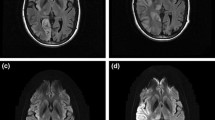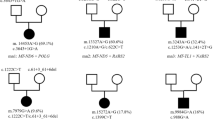Abstract
Primary mitochondrial disorders are highly variable in clinical presentation, biochemistry, and molecular etiology. Mitochondrial disorders can be caused by genetic defects in the mitochondrial, in nuclear genome, or in the interplay between the two genomes. Biochemical screening tests may be inconclusive or misleading since patients, with confirmed mitochondrial disorders specially in pediatric age, may exhibit normal routine biochemistry, muscle histology, or enzymatic analysis of the mitochondrial respiratory chain. Diagnosis is often challenging even with combination of multiple criteria (clinical, biochemical, histological, and functional), as innumerous conditions cause secondary mitochondrial dysfunction. Nowadays, a definite diagnosis is only possible by genetic confirmation since no single score system is satisfactorily accurate, being sensitive but not specific.
Conclusion: Awareness between physicians is of major importance considering that clinical suspicion may not be obvious regarding the heterogenicity in presentation and biochemical features of mitochondrial disorders. In this review, we provide information on diagnosis approach to patients suspected for mitochondrial disorders as well as management on chronic and acute settings. Follow-up should provide comprehensive information on patient’s status, since intervention on these diseases is mostly supportive and prognosis is variable and sometimes unpredictable.
What is Known: • Mitochondrial disorders are heterogenous and may present at any age, with any symptoms and any type of inheritance. • Mitochondrial disorders may be due to pathogenic variants in mitochondrial DNA (mtDNA) or nuclear genes (nDNA). | |
What is New: • Since no single score system is satisfactorily accurate, a definite diagnosis is only possible with genetic studies with gene panels proving to be a cost-effective approach. • Clinical and biochemical features of patients without a confirmed diagnosis must be reviewed and other diagnosis must be considered. A wider genetic approach may be applied (WES or WGS). |



Similar content being viewed by others
Abbreviations
- ATP:
-
Adenosine triphosphate
- DNA:
-
Deoxyribonucleic acid
- LHON:
-
Leber hereditary optic neuropathy
- MELAS:
-
Mitochondrial encephalomyopathy, lactic acidosis and stroke-like episodes
- MERRF:
-
Myoclonic epilepsy with red ragged fibers
- MRI:
-
Magnetic resonance imaging
- mtDNA:
-
Mitochondrial DNA
- NARP:
-
Neuropathy with ataxia and retinitis pigmentosa
- nDNA:
-
Nuclear DNA
- OXPHOS:
-
Oxidative phosphorylation
- PEO:
-
Progressive external ophthalmoplegia
- RRF:
-
Red ragged fiber
- WES:
-
Whole exome sequence
- WGS:
-
Whole genome sequence
References
Alston CL, Rocha MC, Lax NZ, Turnbull DM, Taylor RW (2017) The genetics and pathology of mitochondrial disease. J Pathol 241:236–250. https://doi.org/10.1002/path.4809
Bernier FP, Boneh A, Dennett X, Chow CW, Cleary MA, Thorburn DR (2002) Diagnostic criteria for respiratory chain disorders in adults and children. Neurology 59:1406–1411. https://doi.org/10.1212/01.WNL.0000033795.17156.00
Blau N, Duran M, Gibson KM, Dionisi Vici C (2014) Physician’s guide to the diagnosis, treatment, and follow-up of inherited metabolic diseases. Springer Berlin Heidelberg, Berlin
Bourgeois JM, Tarnopolsky MA (2004) Pathology of skeletal muscle in mitochondrial disorders. Mitochondrion 4:441–452. https://doi.org/10.1016/j.mito.2004.07.036
Calvo SE, Compton AG, Hershman SG, Lim SC, Lieber S, Tucker EJ, Laskowski A, Garone C, Liu S, Jaffe DB, Christodoulou J, Fletcher JM, Bruno DL (2012) Molecular diagnosis of infantile mitochondrial disease with targeted next-generation sequencing. Sci Transl Med 4:1–28. https://doi.org/10.1126/scitranslmed.3003310.Molecular
Caracausi M, Ghini V, Locatelli C, Mericio M, Piovesan A, Antonaros F, Pelleri MC, Vitale L, Vacca RA, Bedetti F, Mimmi MC, Luchinat C, Turano P, Strippoli P, Cocchi G (2018) Plasma and urinary metabolomic profiles of Down syndrome correlate with alteration of mitochondrial metabolism. Sci Rep 8:1–16. https://doi.org/10.1038/s41598-018-20834-y
Carroll CJ, Brilhante V, Suomalainen A (2014) Next-generation sequencing for mitochondrial disorders. Br J Pharmacol 171:1837–1853. https://doi.org/10.1111/bph.12469
Challa S, Kanikannan MA, Murthy JM, Bhoompally VR, Surath M (2004) Diagnosis of mitochondrial diseases: clinical and histological study of sixty patients with ragged red fibers. Neurol India 52:353–358
Chi C-S (2015) Diagnostic approach in infants and children with mitochondrial diseases. Pediatr Neonatol 56:7–18. https://doi.org/10.1016/j.pedneo.2014.03.009
Chow J, Rahman J, Achermann JC, Dattani MT, Rahman S (2017) Mitochondrial disease and endocrine dysfunction. Nat Rev Endocrinol 13:92–104. https://doi.org/10.1038/nrendo.2016.151
Clinical Molecular Genetics Society (2008) Practice guidelines for the molecular diagnosis of mitochondrial diseases. Available online: http://www.acgs.uk.com/media/774659/mito_2008.pdf
Debray FG, Lambert M, Allard P, Mitchell GA (2010) Low citrulline in leigh disease: still a biomarker of maternally inherited leigh syndrome. J Child Neurol 25:1000–1002. https://doi.org/10.1177/0883073809351983
Demine S, Reddy N, Renard P, Raes M, Arnould T (2014) Unraveling biochemical pathways affected by mitochondrial dysfunctions using metabolomic approaches. Metabolites 4:831–878. https://doi.org/10.3390/metabo4030831
DiMauro S, Schon EA (2003) Mitochondrial respiratory-chain diseases. N Engl J Med 348:2656–2668. https://doi.org/10.1056/NEJMra022567
Emma F, Montini G, Parikh SM, Salviati L (2016) Mitochondrial dysfunction in inherited renal disease and acute kidney injury. Nat Rev Nephrol 12:267–280. https://doi.org/10.1038/nrneph.2015.214
Enns GM, Cohen BH (2017) Clinical trials in mitochondrial disease. J Inborn Errors Metab Screen 5:232640981773301. https://doi.org/10.1177/2326409817733013
Feichtinger RG, Sperl W, Bauer JW, Kofler B (2014) Mitochondrial dysfunction: a neglected component of skin diseases. Exp Dermatol 23:607–614. https://doi.org/10.1111/exd.12484
Finsterer J, Bindu PS (2015) Therapeutic strategies for mitochondrial disorders. Pediatr Neurol 52:302–313. https://doi.org/10.1016/j.pediatrneurol.2014.06.023
Finsterer J, Segall L (2010) Drugs interfering with mitochondrial disorders. Drug Chem Toxicol 33:138–151. https://doi.org/10.3109/01480540903207076
Finsterer J, Zarrouk Mahjoub S (2012) Mitochondrial toxicity of antiepileptic drugs and their tolerability in mitochondrial disorders. Expert Opin Drug Metab Toxicol 8:71–79. https://doi.org/10.1517/17425255.2012.644535
Grady JP, Campbell G, Ratnaike T, Blakely EL, Falkous G, Nesbitt V, Schaefer AM, Mcnally RJ, Gorman GS, Taylor RW, Turnbull DM, Mcfarland R (2014) Disease progression in patients with single, large-scale mitochondrial DNA deletions. Brain 137:323–334. https://doi.org/10.1093/brain/awt321
Kohda M, Tokuzawa Y, Kishita Y, Nyuzuki H, Moriyama Y, Mizuno Y, Hirata T, Yatsuka Y, Yamashita-Sugahara Y, Nakachi Y, Kato H, Okuda A, Tamaru S, Borna NN, Banshoya K, Aigaki T, Sato-Miyata Y, Ohnuma K, Suzuki T, Nagao A, Maehata H, Matsuda F, Higasa K, Nagasaki M, Yasuda J, Yamamoto M, Fushimi T, Shimura M, Kaiho-Ichimoto K, Harashima H, Yamazaki T, Mori M, Murayama K, Ohtake A, Okazaki Y (2016) A comprehensive genomic analysis reveals the genetic landscape of mitochondrial respiratory chain complex deficiencies. PLoS Genet 12:1–31. https://doi.org/10.1371/journal.pgen.1005679
Lamari F, Saudubray J-M, Mitchell GA (2016) Inborn metabolic diseases, 6th edn. Springer Berlin Heidelberg, Berlin
Legati A, Reyes A, Nasca A, Invernizzi F, Lamantea E, Tiranti V, Garavaglia B, Lamperti C, Ardissone A, Moroni I, Robinson A, Ghezzi D, Zeviani M (2016) New genes and pathomechanisms in mitochondrial disorders unraveled by NGS technologies. Biochim Biophys Acta Bioenerg 1857:1326–1335. https://doi.org/10.1016/j.bbabio.2016.02.022
Liang C, Ahmad K, Sue CM (2014) The broadening spectrum of mitochondrial disease: shifts in the diagnostic paradigm. Biochim Biophys Acta Gen Subj 1840:1360–1367. https://doi.org/10.1016/j.bbagen.2013.10.040
Liu JJ, Ghosh S, Kovalik JP, Ching J, Choi HW, Tavintharan S, Ong CN, Sum CF, Summers SA, Tai ES, Lim SC (2017) Profiling of plasma metabolites suggests altered mitochondrial fuel usage and remodeling of sphingolipid metabolism in individuals with type 2 diabetes and kidney disease. Kidney Int Reports 2:470–480. https://doi.org/10.1016/j.ekir.2016.12.003
McCormick E, Place E, Falk MJ (2013) Molecular genetic testing for mitochondrial disease: from one generation to the next. Neurotherapeutics 10:251–261. https://doi.org/10.1007/s13311-012-0174-1
Montero R, Yubero D, Villarroya J, Henares D, Jou C, Rodríguez MA, Ramos F, Nascimento A, Ortez CI, Campistol J, Perez-due B (2016) GDF-15 is elevated in children with mitochondrial diseases and is induced by mitochondrial dysfunction. 1–15. https://doi.org/10.1371/journal.pone.0148709
Niezgoda J, Morgan PG (2013) Anesthetic considerations in patients with mitochondrial defects. Paediatr Anaesth 23:785–793. https://doi.org/10.1111/pan.12158
Nogueira C, Almeida LS, Nesti C, Pezzini I, Videira A, Vilarinho L, Santorelli FM (2014) Syndromes associated with mitochondrial DNA depletion. Ital J Pediatr 40:1–10. https://doi.org/10.1186/1824-7288-40-34
Ohtake A, Murayama K, Mori M, Harashima H, Yamazaki T, Tamaru S, Yamashita Y, Kishita Y, Nakachi Y, Kohda M, Tokuzawa Y, Mizuno Y, Moriyama Y, Kato H, Okazaki Y (2014) Diagnosis and molecular basis of mitochondrial respiratory chain disorders: exome sequencing for disease gene identification. Biochim Biophys Acta Gen Subj 1840:1355–1359. https://doi.org/10.1016/j.bbagen.2014.01.025
Parikh S, Goldstein A, Koenig MK, Scaglia F, Enns GM, Saneto R, Anselm I, Cohen BH, Falk MJ, Greene C, Gropman AL, Haas R, Hirano M, Morgan P, Sims K, Tarnopolsky M, Van Hove JLK, Wolfe L, DiMauro S (2015) Diagnosis and management of mitochondrial disease: a consensus statement from the Mitochondrial Medicine Society. Genet Med 17:689–701. https://doi.org/10.1038/gim.2014.177
Parikh S, Goldstein A, Karaa A, Koenig MK, Anselm I, Brunel-Guitton C, Christodoulou J, Cohen BH, Dimmock D, Enns GM, Falk MJ, Feigenbaum A, Frye RE, Ganesh J, Griesemer D, Haas R, Horvath R, Korson M, Kruer MC, Mancuso M, McCormack S, Raboisson MJ, Reimschisel T, Salvarinova R, Saneto RP, Scaglia F, Shoffner J, Stacpoole PW, Sue CM, Tarnopolsky M, Van Karnebeek C, Wolfe LA, Cunningham ZZ, Rahman S, Chinnery PF (2017) Patient care standards for primary mitochondrial disease: a consensus statement from the Mitochondrial Medicine Society. Genet Med 19. https://doi.org/10.1038/gim.2017.107
Rahman S, Wolf NI (2017) Diagnostic Workup of Patients with Mitochondrial Diseases. In: Hoffmann G, Zschocke J, Nyhan W (eds) Inherited Metabolic Diseases. Springer, Berlin
Salway JG (2017) Metabolism at a glance, 4th edn. Wiley-Blackwell Publishing, Oxford
Shaham O, Slate NG, Goldberger O, Xu Q, Ramanathan A, Souza AL, Clish CB, Sims KB, Mootha VK (2010) A plasma signature of human mitochondrial disease revealed through metabolic profiling of spent media from cultured muscle cells. Proc Natl Acad Sci 107:1571–1575. https://doi.org/10.1073/pnas.0906039107
Taylor RW, Turnbull DM (2005) Mitochondrial DNA mutations in human disease. Nat Rev Genet 6:389–402. https://doi.org/10.1038/nrg1606
Vilarinho L (2000) Genética Mitocondrial Humana (Doctoral dissertation), Universidade do Porto
Vilarinho L, Santorelli FM, Cardoso ML, Coelho T, Guimarães A, Coutinho P (1998) Mitochondrial DNA analysis in ocular myopathy. Eur Neurol 39:148–153. https://doi.org/10.1159/000007925
Vilarinho L, Santorelli FM, Coelho I, Rodrigues L, Maia M, Barata I, Cabral P, Dionísio A, Costa A, Guimarães A, Dimauro S (1999) The mitochondrial DNA A3243G mutation in Portugal: clinical and molecular studies in 5 families. J Neurol Sci 163:168–174. https://doi.org/10.1016/S0022-510X(99)00030-1
Viscomi C, Bottani E, Zeviani M (2015) Emerging concepts in the therapy of mitochondrial disease. Biochim Biophys Acta Bioenerg 1847:544–557. https://doi.org/10.1016/j.bbabio.2015.03.001
Wolf NI, Smeitink JAM (2002) Mitochondrial disorders: a proposal for consensus diagnostic criteria in infants and children. Neurology 59:1402–1405. https://doi.org/10.1212/01.WNL.0000031795.91814.D8
Wong LJ (2013) Next generation molecular diagnosis of mitochondrial disorders. Mitochondrion 13:379–387. https://doi.org/10.1016/j.mito.2013.02.001
Wortmann SB, Mayr JA, Nuoffer JM, Prokisch H, Sperl W (2017) A guideline for the diagnosis of pediatric mitochondrial disease: the value of muscle and skin biopsies in the genetics era. Neuropediatrics 48:309–314. https://doi.org/10.1055/s-0037-1603776
Zhang H, Wang F, Xiao H, Yao Y (2018) The ratio of urinary α1-microglobulin to microalbumin can be used as a diagnostic criterion for tubuloproteinuria. Intractable Rare Dis Res 7:46–50. https://doi.org/10.5582/irdr.2017.01079
Funding
The customized gene panel referred in this paper was supported by FCT (PTDC/DTP-PIC/2220/2014) and NORTE2020 (NORTE-01-0246-FEDER-000014).
Author information
Authors and Affiliations
Contributions
Margarida Paiva Coelho: review of literature and article drafting
Esmeralda Martins: critical manuscript review
Laura Vilarinho: critical manuscript review
Corresponding author
Ethics declarations
This article does not contain any studies with human participants or animals performed by any of the authors.
Conflict of interests
The authors declare that they have no conflict of interest.
Additional information
Communicated by Peter de Winter
Rights and permissions
About this article
Cite this article
Paiva Coelho, M., Martins, E. & Vilarinho, L. Diagnosis, management, and follow-up of mitochondrial disorders in childhood: a personalized medicine in the new era of genome sequence. Eur J Pediatr 178, 21–32 (2019). https://doi.org/10.1007/s00431-018-3292-x
Received:
Revised:
Accepted:
Published:
Issue Date:
DOI: https://doi.org/10.1007/s00431-018-3292-x




